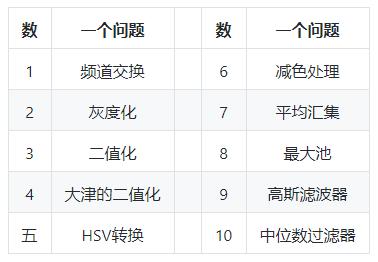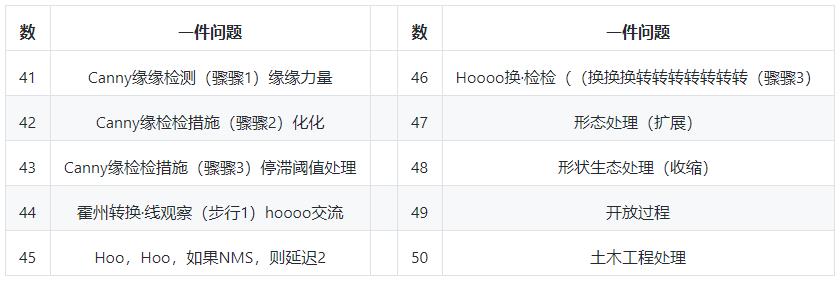OpenCV 机器视觉入门精选 100 题(附 Python 代码)
Posted AI有道
tags:
篇首语:本文由小常识网(cha138.com)小编为大家整理,主要介绍了OpenCV 机器视觉入门精选 100 题(附 Python 代码)相关的知识,希望对你有一定的参考价值。
重磅干货,第一时间送达

如今深度学习的快速发展给计算机视觉注入了前所未有的新活力!其中在计算机图形学和计算机视觉里面最流行的一个库就是 OpenCV。OpenCV 在自动驾驶和仿生机器人当中的应用非常广泛。
而在 2018 年 11 月份,OpenCV 通过 GITHUB 正式发布了 OpenCV 又一个重要里程碑版本 OpenCV 4.0。
https://github.com/yoyoyo-yo/Gasyori100knock

极简安装:
作者推荐了 OpenCV 的极简安装方法:
1. 安装 MiniConda
2. 创建虚拟环境并激活
$ conda create python = 3.6 - n gasyori 100
$ source actiavte gasyori 1003. 安装包
$ pip install -r requirement.txt其中,requirement.txt 文件在项目根目录下,下载至命令行所在目录直接运行上述命令即可。
100 题实例:
作者写的 OpenCV 100 题按照从简单到复杂逐一解析,非常适合我们的学习路径。
例如 Q1-10:

我们首先来看一个简单的例子。
Q1. 读取图像并按 BGR 顺序更改 RGB
import cv2
# Read image
img = cv2.imread("imori.jpg")
b = img[:, :, 0].copy()
g = img[:, :, 1].copy()
r = img[:, :, 2].copy()
# RGB > BGR
img[:, :, 0] = r
img[:, :, 1] = g
img[:, :, 2] = b
# Save result
cv2.imwrite("out.jpg", img)
cv2.imshow("result", img)
cv2.waitKey(0)
cv2.destroyAllWindows()

例如 Q41-50:

我们来看一个稍微复杂的例子。
Q41. Canny边缘检测(步骤1)边缘强度
import cv2
import numpy as np
import matplotlib.pyplot as plt
# Read image
img = cv2.imread("imori.jpg").astype(np.float32)
H, W, C = img.shape
# Gray
gray = 0.2126 * img[..., 2] + 0.7152 * img[..., 1] + 0.0722 * img[..., 0]
# Gaussian Filter
K_size = 5
sigma = 1.4
## Zero padding
pad = K_size // 2
gau = np.zeros((H + pad*2, W + pad*2), dtype=np.float32)
#gau[pad:pad+H, pad:pad+W] = gray.copy().astype(np.float32)
gau = np.pad(gray, (pad, pad), 'edge')
tmp = gau.copy()
## Kernel
K = np.zeros((K_size, K_size), dtype=np.float32)
for x in range(-pad, -pad+K_size):
for y in range(-pad, -pad+K_size):
K[y+pad, x+pad] = np.exp( -(x**2 + y**2) / (2* (sigma**2)))
K /= (sigma * np.sqrt(2 * np.pi))
K /= K.sum()
for y in range(H):
for x in range(W):
gau[pad+y, pad+x] = np.sum(K * tmp[y:y+K_size, x:x+K_size])
## Sobel vertical
KSV = np.array(((-1., -2., -1.), (0., 0., 0.), (1., 2., 1.)), dtype=np.float32)
## Sobel horizontal
KSH = np.array(((-1., 0., 1.), (-2., 0., 2.), (-1., 0., 1.)), dtype=np.float32)
gau = gau[pad-1:H+pad+1, pad-1:W+pad+1]
fy = np.zeros_like(gau, dtype=np.float32)
fx = np.zeros_like(gau, dtype=np.float32)
K_size = 3
pad = K_size // 2
for y in range(H):
for x in range(W):
fy[pad+y, pad+x] = np.sum(KSV * gau[y:y+K_size, x:x+K_size])
fx[pad+y, pad+x] = np.sum(KSH * gau[y:y+K_size, x:x+K_size])
fx = fx[pad:pad+H, pad:pad+W]
fy = fy[pad:pad+H, pad:pad+W]
# Non-maximum suppression
edge = np.sqrt(np.power(fx, 2) + np.power(fy, 2))
fx[fx == 0] = 1e-5
tan = np.arctan(fy / fx)
## Angle quantization
angle = np.zeros_like(tan, dtype=np.uint8)
angle[np.where((tan > -0.4142) & (tan <= 0.4142))] = 0
angle[np.where((tan > 0.4142) & (tan < 2.4142))] = 45
angle[np.where((tan >= 2.4142) | (tan <= -2.4142))] = 95
angle[np.where((tan > -2.4142) & (tan <= -0.4142))] = 135
out = angle.astype(np.uint8)
# Save result
cv2.imwrite("out.jpg", out)
cv2.imshow("result", out)
cv2.waitKey(0)
cv2.destroyAllWindows()
项目特色:
该项目最大的特色就是 100 题循序渐进,基本涵盖了 OpenCV 的关键知识点,目前已经更新了前 60 题,后续的会陆续发布。
唯一的缺点是项目语言是日语,稍有不便。但是问题不大,笔者推荐一个方法,可以使用谷歌浏览器自动翻译网页即可。而且,所有的代码都是英文的,不妨碍理解。
如果你正在入门 CV,正在学习 OpenCV,那么这个项目将会是一个不错的从入门到进阶的教程。上手代码,亲自跑一跑结果,希望对大家有所帮助!
【推荐阅读】
以上是关于OpenCV 机器视觉入门精选 100 题(附 Python 代码)的主要内容,如果未能解决你的问题,请参考以下文章